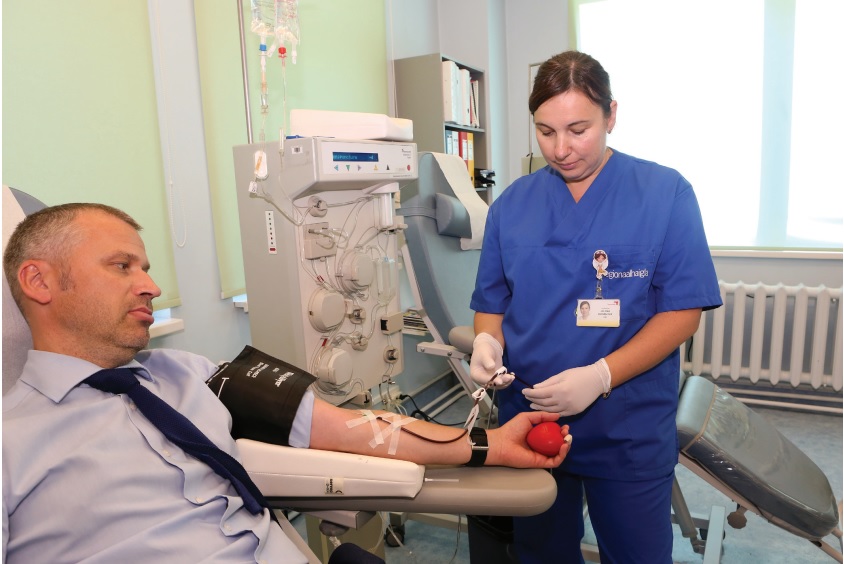Tõnu

“During one of my usual visits to donate blood, I saw a certain number of people giving blood while being hooked on special machines. I’ve been a blood donor for over 10 years. I became curious – this was something new and I wanted to try it, too,” Tõnu recalls. “I asked the doctors of the Blood Centre whether I was eligible to become an apheresis donor”. He was deemed fully suitable and completed his first procedure on 17 June 2009. To date, he has undergone 58.
The term Apheresis comes from the Greek word ‘Aphairesis’ and signifies the process of extracting certain blood cells or plasma from whole blood using a special machine. The other blood constituents are transferred back to the donor. Some patients who suffer from serious conditions may require blood platelets in an amount that usually requires the platelets of four full blood donors. Apheresis allows these to be obtained simultaneously from the same donor. Apheresis donors can give blood more frequently. “While male blood donors can give blood four to five times per year on average, apheresis donors can even donate every two weeks, if necessary.” There was one time when the Blood Centre called me two weeks after my previous donation and asked me to come in again. A little patient from the children’s hospital needed the plasma of my blood group in particular. However, to date, this has been the only time I’ve had to donate blood this frequently. I have agreed with the doctors of the Blood Centre to come in for an apheresis once a month. They call me in.” After receiving a call, Tõnu takes a couple of days to prepare for the procedure. “I have followed a healthy diet and done sports all my life and it’s not a problem for me. Drinking a lot of water during the days before a blood donation is of paramount importance to me. I’ve noticed that apheresis is quicker and smoother if my blood is thinner. I also avoid fatty food. I still have no clue how the Blood Centre’s doctors are able to get an overview of my diet. A few times they have joked about me having eaten roast pork the day before merely on the basis of the transparent plastic bag containing my donated plasma.”
What does the procedure involve?
The Medical Centre’s Ädala Street Blood Centre performs multicomponent apheresis and plasma apheresis procedures. “I’m a plasma apheresis donor, which means that they use the centrifugation method to extract only plasma components from my blood. The rest of it is put back, so to say,” Tõnu smiles. “There aren’t other any differences except the duration of the donation time and the amounts donated. Regular blood donation takes 7-10 minutes, but apheresis donors must lie down while being connected to a special machine for 40-50 minutes. While a blood donor donates 450 ml of blood per one procedure, I as an apheresis donor can give 720 ml of plasma.”
During the procedure, either blood platelets or plasma are extracted from this amount and the rest of the blood components are transferred back to the donor. The donor’s blood platelet count is checked before apheresis and the device determines the amount that can be extracted to ensure that their level in the donor’s blood remains normal after the procedure. The donor’s blood pressure is also monitored throughout the procedure.
“The apheresis procedure is entirely safe for the donor,” emphasises Tõnu. “The fact that the veins are under quite a strain can be considered the only unpleasant aspect of blood donation. The needle that is inserted in the vein to collect blood is quite thick. This is likely the reason why apheresis donors are mostly men – they simply have more suitable veins and stronger vascular walls,” says the experienced donor. Doctors also check the condition of veins before declaring the donor eligible for apheresis.
Requirements for apheresis donors
“The eligibility criteria are roughly the same as in the case of blood donors: good health, i.e. good blood test results, suitable age, sufficient body weight and good veins. Haemoglobin and blood pressure indicators must certainly be in the normal range. Apheresis donors must also have previous experience in donating blood. They must have donated blood at least two times in the last two years without having any side-effects,” says Tõnu.
He has been an apheresis donor for so long that he does not even notice any big changes in his health status after the procedure. “Years ago, when I started donating blood I did feel somewhat lighter and well-rested on the day following the procedure, which is understandable – blood cells do regenerate. I haven’t felt like this after apheresis myself, but I haven’t felt tired or weak either. At the same time, I have heard that apheresis has the same invigorating effect on other donors as usual blood donation,” he says.
“I do hope there are other apheresis donors in the Medical Centre. Doing good feels incredible. I encourage all of my colleagues to donate blood.”